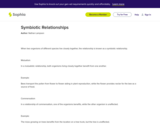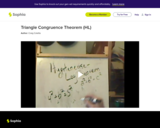
This lesson will introduce the three types of symbiotic relationships and give examples of each. It is 4 of 4 in the series titled "Symbiotic Relationships."
- Subject:
- Science
- Material Type:
- Module
- Provider:
- Sophia Learning
- Date Added:
- 12/01/2023

This lesson will introduce the three types of symbiotic relationships and give examples of each. It is 4 of 4 in the series titled "Symbiotic Relationships."

This screencast lesson introduces synonym context clues. [2:32]

This lesson explains how to substitute the synonym to check that the guessed meaning of unknown vocabulary is correct. This tutorial lesson shares a short screencast with the lesson's content. [2:15]

This screencast defines synonyms, explains their importance, and demonstrates how to find them using Thesaurus.com and the thesaurus in Microsoft Word. [4:32]

Use synthetic division to determine if a linear form is a factor of a given polynomial. Check understanding with a quiz. [3:22]

In this lesson the concept of a T-chart is explained. It is 1 of 5 in the series titled "T Chart." The video tutorial is accompanied by a short multiple-choice quiz. [2:25]

In this lesson, the concept of a T-chart is explained. It is 3 of 5 in the series titled "T Chart." The video tutorial is accompanied by a short multiple-choice quiz. [1:44]

In this lesson the concept of a T-chart is explained. It is 5 of 5 in the series titled "T Chart." There is a short video tutorial in addition to questions. [3:46]

A video lesson explaining how tension forces can be used to determine the force of friction acting on an object. [6:33]

A video lesson describing the forces of tension in ropes. [1:59]

This lesson will provide an understanding of the characteristics and role of terrestrial biomes, and its effect on living things. It is 3 of 3 in the series titled "Terrestrial Biomes."

Through illustrated notes and a related video, students will gain an understanding of comparative advantage and why trade is beneficial. [4:10]

Learn how to reflect a geometric figure across the coordinate plane in this video tutorial. [7:07] Assess learning with a quiz.

This video lesson [3:32] demsonstrates how to rotate geometric figures in the coordinate plane. Students can check their understanding with an assessment.

A variety of presentation formats including notes, a PowerPoint presentation, exercises, a game, and a video [1:46] explaining transition words and their function as well as providing examples of transition words to be used for specific purposes. W.11-12.1c Transitions/Cohesion

This screencast introduces transition words and their roles. It is 6 of 8 in the series titled "Transition Words." [3:36]

A screencast about transitioning from one topic to the next. It is 2 of 2 in the series titled "Transitioning Topics Effectively." [5:52]

Through a series of video lectures and some review questions, learn about the Bohr model of the atom and the periodic table of elements. [7:51]

This lesson will present the Hypotenuse-Leg Triangle Congruence Theorem. It is 1 of 5 in the series titled "Triangle Congruence Theorem (HL)." [5:01]

This lesson will present the Hypotenuse-Leg Triangle Congruence Theorem. It is 3 of 5 in the series titled "Triangle Congruence Theorem (HL)." [4:06]